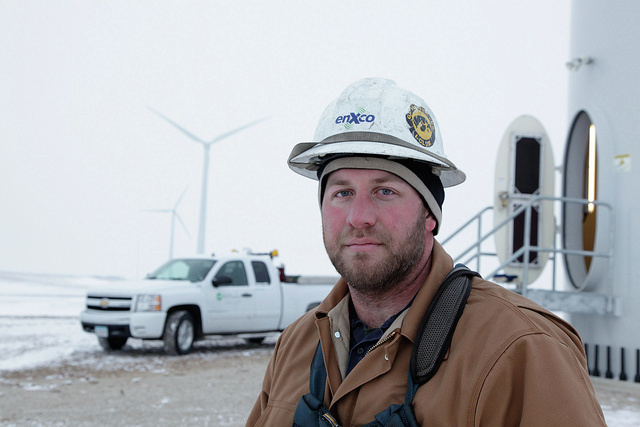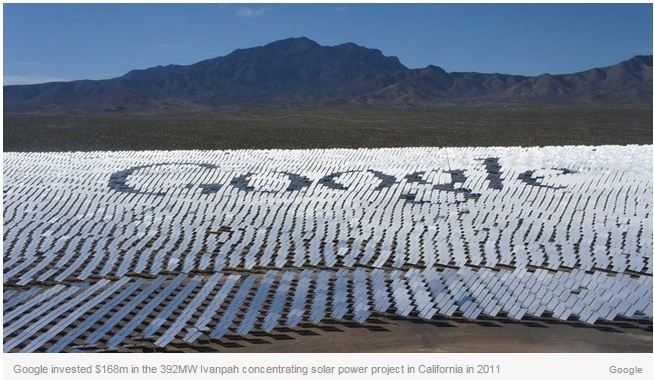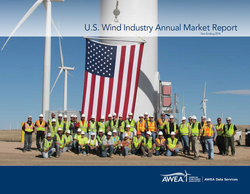News Release from American Clean Power Association (ACP)
Wind Industry Profile of
American wind energy rebounded in 2014; “wind rush” underway in Texas
American wind industry jobs and turbine deployment regained momentum heading into 2015, the American Wind Energy Association (AWEA) reported today in releasing its 2014 results in the U.S. Wind Industry Annual Market Report.
The U.S. wind industry added 23,000 jobs in 2014, boosting the sector’s total to 73,000 jobs. 2015 began with 12,700 MW of wind projects under construction, a record for the start of any year.
“These results show that extending the Production Tax Credit for wind power in 2013 was good for business in America,” said Tom Kiernan, CEO of AWEA. “We’ve got a mainstream, Made-in-the-USA product that supports jobs in every state and is gaining momentum. With a more predictable policy we can add more jobs and keep this American success story going.”
Four times more new wind generating capacity came online last year than in 2013. 2013 wind deployment was down 92 percent from 2012 levels because of policy uncertainty caused by the brief lapse of the Production Tax Credit (PTC) at the end of 2012. That lapse resulted in the loss of 30,000 wind industry jobs in America.
In the U.S. wind manufacturing sector specifically, wind now employs nearly 20,000 workers in more than 500 facilities across 43 states, in addition to 53,000 other jobs in project development, construction, operations, and other parts of the industry. The U.S. wind industry drove $12 billion in private investment last year, for a total of more than $100 billion since 2008.
The success of the PTC is on full display in states like Iowa, where wind energy has attracted $10 billion in cumulative investment and supports 6,000 jobs. In 2014, Iowa Republican Rep. Steve King led a bipartisan letter calling for an extension of the PTC that was signed by 118 members of Congress and sent it to House Speaker John Boehner.

“Iowa gets nearly 30 percent of its electricity from homegrown wind power, more than any other state,” said Representative King. “Thanks to technological improvements and scaling up domestic manufacturing, the U.S. wind industry has reduced the cost of wind energy by more than half over the last five years. It was the intent of Congress to create an alternative production source of American electricity. Wind will never be an energy source we have to import and now, we have American homegrown supplies of turbines, towers, and blades. The wind industry has done what Congress asked them to do. Congress needs to hold up their part of the bargain.”
By holding up their end of the bargain, Congress can allow this effective policy to successfully complete the job it was designed to do.
“The PTC enabled the private sector to make critical investments in domestic manufacturing and the American workforce, driving significant cost reductions. That has driven technology improvements and cost reductions that are creating a modern-day ‘wind rush’ by opening up new areas for development,” said AWEA Deputy Director of Industry Data and Analysis Emily Williams. “We have utility-scale turbines operating in 39 states today, and if these trends continue and stable policy is in place, we can see wind deployment in even more states.”
A U.S. Department of Energy report released last month shows that wind energy can double within the next five years to supply 10 percent of U.S. electricity by 2020, 20 percent by 2030, and 35 percent by 2050.
State-by-state economic benefits and rankings
The U.S. “wind rush” is at its height in Texas, with 7,500 MW of wind projects currently under construction, more than all other states combined. The wind industry invested $3 billion in Texas last year, bringing total cumulative investment to over $26 billion.
“The strong activity we’re seeing in Texas right now can be traced back to a strong, successful policy – namely the PTC,” said Steve Irvin, Executive Vice President of EDP Renewables North America, whose company has operating wind farms in Texas, and is slated to begin construction on more in the state. EDP Renewables ranks amongst the top five owners of wind farms in the U.S. “Extending the tax credit is critical for us to have the stability we need to plan our business and do our part to help grow this homegrown industry.”
"Texas is enjoying a rural economic development boom thanks to wind energy investments in our state," said Jeff Clark, Executive Director of the Texas-based Wind Coalition. "Wind energy projects are putting Texans to work, lowering energy prices for consumers, and bringing dramatic increases to local tax bases. Texas policies are succeeding. With the legislature meeting in Austin, we urge Texas lawmakers to stay the course on renewable energy and continue to invite energy investment in our growing state."
The completion of the Competitive Renewable Energy Zone (CREZ) transmission lines a year ago has played a critical role in opening up Texas’s world-class wind resources to development. That success will soon be replicated in other parts of the Plains and the Midwest, which are following suit with major new transmission upgrades.
The Texas wind boom resulted in the addition of 9,000 jobs in 2014, bringing Texas to a U.S.-leading 17,000 wind industry jobs. Rounding out the top five states with the most wind industry jobs are Iowa and Colorado with over 6,000 jobs each, Oklahoma with nearly 5,000 jobs, and Michigan with over 3,000 jobs.

Ohio again ranks number one in wind manufacturing facilities, while Colorado and then Iowa lead with the most manufacturing jobs.

U.S. continues to lead world in wind energy production
Thanks to performance-based incentives like the PTC, the U.S. leads the world in wind energy production. In 2014, U.S. wind farms produced over 181 billion kWh of wind energy, enough to power the equivalent of 16.7 million American homes.
Wind generation has more than tripled since 2008, providing 4.4 percent of the nation’s electricity in 2014. Wind energy provided the largest increase in generation for any energy source in 2014.

Iowa led the nation by producing 28.5 percent of its electricity from wind power, followed by South Dakota at 25.3 percent and Kansas at 21.7 percent in 2014. Wind energy provided more than 15 percent of the total electricity generated in seven states, more than 10 percent in a total of nine states, and more than five percent in a total of 19 states.
Wind energy was the primary choice for new generating capacity in the wind-rich Midwest, Pacific Northwest, and Plains regions, providing 60 percent or more of all new electric generation capacity in those areas between 2011 and 2014.
Consumers attracted by stably-priced wind energy
Consumers are increasingly attracted by wind energy’s unique lack of fuel cost, which builds a more balanced energy portfolio that protects against increases in the price of other fuels. A record of 11,000 MW of long-term wind power purchase agreements (PPAs) were signed in 2013-2014.
Utilities aren’t the only companies buying wind power. At least 60 non-utility entities have made long-term wind energy purchases, including Microsoft, Dow Chemical, Google, Ikea, Walmart, and other household names. Over 23 percent of the wind capacity contracted through 2014 power purchase agreements was with non-utility purchasers.

“Our ability to lock-in wind power’s competitive prices over the long-term allows us to hedge against rising prices for other fuels, saving us money,” said Brian Janous, Director of Energy Strategy for Microsoft. “Wind power benefits our bottom-line while also meeting our desire to positively impact the environment.”
Outside of the corporate sector, the U.S. General Services Administration and Cornell University added their names to the growing list of agencies and universities purchasing wind power, which already includes Oklahoma State University, the Ohio State University, and the U.S. Air Force.
Wind offers states a low-cost compliance tool to meet Clean Power Plan, helps save water
Wind energy production avoided an estimated 125 million metric tons of carbon dioxide during 2014 – more than 5.7 percent of U.S. power sector emissions or the equivalent annual emissions of 26 million cars. This benefit is drawing the attention of many states and utilities who are seeking a low-cost way to comply with EPA’s proposal to reduce carbon pollution from existing power plants through the Clean Power Plan.

Wind energy also avoided the consumption of over 68 billion gallons of water in the U.S. in 2014, the equivalent of conserving roughly 215 gallons per person in the U.S. or 517 billion bottles of water. This is an increasingly valuable benefit as severe drought continues to affect many of America’s primary wind-producing regions. For example, in drought-ravaged California, wind energy saved 2.5 billion gallons of freshwater in 2014, while Texas led the nation with savings of 13 billion gallons of water.

Successful policy must continue
America’s energy future is at a crossroads. Near-term uncertainty about the PTC puts the wind industry’s73,000 jobs and the domestic supply chain investments that have driven tremendous cost reductions at risk. Extending the PTC for as long as possible, as soon as possible, will ensure that the wind industry can continue making investments in American manufacturing to lower costs and improve productivity.
The growth of the wind industry will be on full display at this year’s WINDPOWER Conference & Exhibition in Orlando, Florida from May 18-21, an event that brings together thousands of the Americans working in the wind energy industry.
To receive more information on this article, our Newsletter or find out more about what w3.windfair.net has to offer, please, do not hesitate to contact Trevor Sievert at ts@windfair.net.
Please don't forget to follow us on Twitter: w3.windfair.net on Twitter
w3.windfair.net is the largest international B2B internet platform in wind energy – ultimately designed for connecting wind energy enthusiasts and companies across the globe
- Source:
- American Wind Energy Association
- Author:
- Trevor Sievert, Online Editorial Journalist / By AWEA Staff
- Email:
- windmail@awea.org
- Link:
- www.awea.org/...


